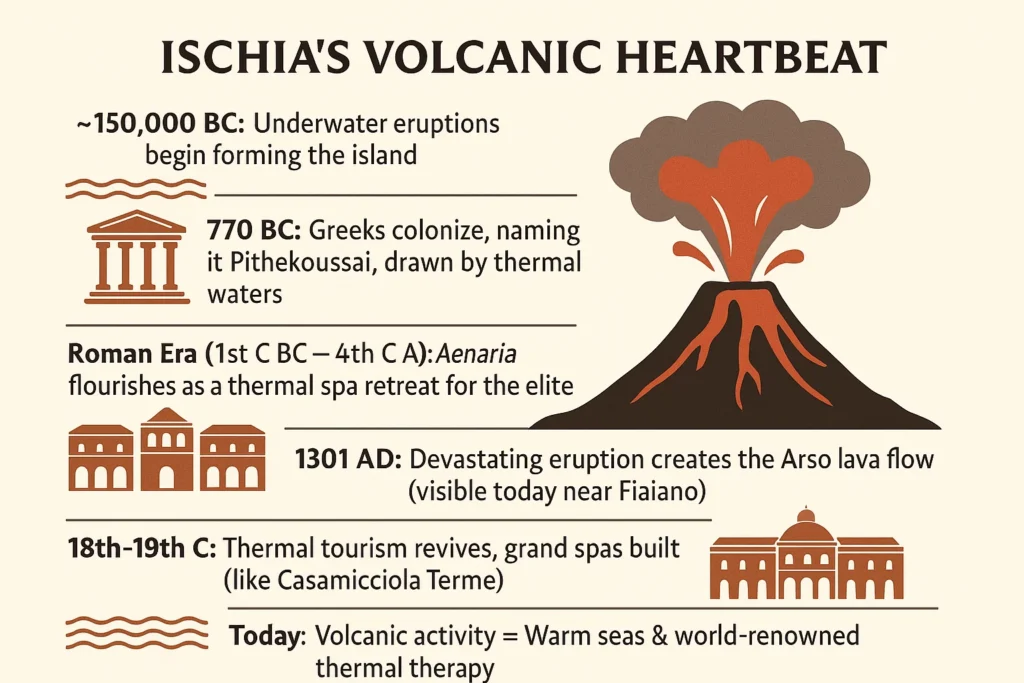Your sandal sinks into warm, black sand as the Tyrrhenian Sea licks at your toes. Above you, Ischia’s Monte Epomeo looms, its slopes draped in vineyards and lemon groves – a sleeping giant whose fiery heart still warms the waters swirling around your ankles. This isn’t just a beach; it’s the edge of a living geological drama that began millennia before Caesar crossed the Rubicon. And perched right on this stage, where myth meets mineral-rich steam, sits Ischia Dimorra Sun. Forget sterile resorts; here, luxury is steeped in the island’s ancient, bubbling soul. Your time-traveling basecamp awaits.
Why Ischia Dimorra Sun is Your Portal to the Past
Ischia isn’t merely scenic; it’s a geological autobiography. Known to the ancient Greeks as Pithekoussai (Island of Monkeys), it was their first colony in the West, established around 770 BC. Why here? The thermal waters. They believed these steamy springs, gifting relief and healing, flowed from the gods themselves. The Romans, ever the practical heirs, transformed the island into a vast, elite spa retreat, calling it Aenaria.
Staying at Ischia Dimorra Sun means sleeping atop this legacy. Its solarium and proximity to the iconic hot public baths of Citara aren’t just amenities; they’re your direct line to rituals practiced for over 2,800 years. Think of the steam rising from the outdoor pool not as condensation, but as the breath of Hephaestus, the Greek god of fire and forge, whose workshop was mythically placed beneath these very islands. When you sink into the warm embrace of the villa’s thermal offerings, you’re partaking in a tradition older than the Colosseum.
Mapping Your Time-Traveler’s Itinerary: Beyond the Villa Gates
Ischia Dimorra Sun is your perfect launchpad. Forio itself is a maze of whitewashed houses, Baroque churches, and hidden courtyards whispering tales of Saracen raids and Spanish viceroys. But venture further:
- Citara Beach & Poseidon Gardens (0.5 km): Literally steps away. Don’t just swim. Feel the history: Imagine Greek colonists easing weary muscles in these same mineral-rich pools. The sprawling Poseidon complex (22 pools!) sits on the site of ancient Roman thermal baths. Touch the rocks – they’re warm with volcanic memory.
- The Aragonese Castle (15 min drive): A fortress-island rising dramatically from the sea. Started by Hiero I of Syracuse in 474 BC, expanded by Romans, turned into a monastery, then a fortress against pirates. Walk its ramparts. Hidden Narrative: Seek out the “Convent of the Clarisses” – its terrace offers a heart-stopping panorama, and the adjacent cemetery tells tales of plague, siege, and quiet faith.
- Villa Arbusto & Pithecusae Museum (Lacco Ameno, 15 min drive): Essential. This museum houses the legendary “Nestor’s Cup” – an 8th-century BC Greek drinking vessel bearing one of the oldest surviving examples of Greek writing in the West. It’s physical proof of Ischia’s pivotal role in spreading Hellenic culture. Seeing it is like holding a direct telegram from Homer’s era.
- Sant’Angelo (20 min drive): A picturesque fishing village clinging to a volcanic rock, accessible only by foot. Wander its narrow paths – pure, timeless Mediterranean charm. Look Down: The very rock it sits on is a volcanic dome.
Ischia’s Thermal Wonders: A Time-Traveler’s Comparison
| Site | Historical Significance | Vibe & Experience | Pro Tip for Explorers | Best Time to Avoid Crowds |
|---|---|---|---|---|
| Poseidon Gardens (Citara) | Built over ancient Roman Baths | Extensive complex (22 pools!), dramatic seaside setting | Arrive at opening (9 AM) for serene morning soak | Early June / Late September |
| Negombo (Lacco Ameno) | Developed mid-20th C, blends art & nature | Lush botanical gardens, unique thermal “path” | Explore the hidden grotto pools | Weekday afternoons |
| Cavascura (Serrara Fontana) | Most ancient, mentioned by Roman scholars | Wild, natural setting in a volcanic gorge | Requires boat/hike – adventurous! | Any time – inherently quieter |
| Ischia Dimorra Sun Solarium/Proximity | Modern luxury on ancient thermal ground | Private, intimate, direct sea views | Sunset soak overlooking Citara Bay | Your private oasis! |
Beyond the Brochures: The Island’s Whispered Secrets
- The Forgotten Necropolis: Near the village of San Montano (close to Lacco Ameno), lies a vast, often-overlooked Greek and Roman necropolis. Wander among the tombs shaded by pines – less crowded, profoundly atmospheric.
- The Miracle of Santa Restituta: In Lacco Ameno, the Basilica houses the remains of the North African martyr Saint Restituta. Legend says her body washed ashore here in a boat guided by angels after her martyrdom. The annual festival (May 16-18) is a vibrant, deeply local experience.
- Volcanic Vineyards: Ischia’s unique Piedirosso and Forastera grapes thrive in mineral-rich volcanic soil. Visit a local cantina (like Cenatiempo in Forio) – the taste is history distilled, echoing Greek and Roman viticulture.

Local Secrets: Dine & Stay Like a Scholar (Who Likes Comfort)
- Breakfast at Bar Calise (Forio): Join locals for sfogliatella (crispy pastry) and strong espresso. Watch the piazza come alive.
- Lunch at Ristorante Da Coco (Sant’Angelo): Fresh seafood on a terrace clinging to the rock. Order coniglio all’ischitana (Ischian rabbit stew) – a dish born from the island’s agricultural roots.
- Dinner at Il Focolare (Forio): Rustic, family-run gem tucked away. Authentic, hearty Ischian fare – feels like eating in a local’s home.
- Sleeping at History’s Edge: Ischia Dimorra Sun offers the perfect blend. Your spacious villa (with kitchen!) means flexibility. Wake up, brew coffee, step onto your balcony overlooking the ancient Bay of Citara. The sea view rooms are worth it – your daily panorama is a millennia-old theater. The convenience of the solarium and pool means history’s embrace is just steps from your door, anytime.
FAQs
Q: Is Ischia Dimorra Sun suitable for exploring with kids?
A: Absolutely! Turn the Aragonese Castle into a pirate fortress adventure. Poseidon Gardens has warm, shallow pools perfect for little ones. The villa’s space and kitchen are family gold.
Q: What’s the most overlooked historical spot near Forio?
A: The Torre di Guevara (“Michele Tower”) in Cartaromana Bay. This 15th-century watchtower stands near submerged Roman ruins. At low tide, hints of ancient walls appear – pure magic at sunset.
Q: Can I visit the thermal sites year-round?
A: Yes! Ischia Dimorra Sun‘s solarium/pool is accessible seasonally (check dates). Major public parks like Poseidon open April-October. Secret Perk: November-March offers misty, atmospheric walks through ancient villages, and some smaller spas/hotel facilities stay open – fewer crowds, authentic local life.
Q: How accessible are the historical sites?
A: The Aragonese Castle involves steep climbs and uneven steps. Poseidon Gardens has many stairs. Citara Beach is sandy but can slope. Ischia Dimorra Sun itself offers good accessibility. Rent a small car or use taxis for flexibility.
Q: Is Ischia just for spa-goers?
A: Myth busted! While thermalism is core, its history (Greek, Roman, medieval), hiking (Epomeo!), vineyards, and stunning coastal scenery offer incredible diversity. Ischia Dimorra Sun places you perfectly for all of it.
Your Time-Traveler’s Toolkit: 3 Essential Tasks
- Download the “Ischia Maps.Me” Offline Map: Essential for navigating narrow lanes and finding hidden paths, especially around Sant’Angelo or rural thermal springs.
- Ask a Local Fisherman about “La Scrofa”: In Sant’Angelo, whisper this phrase (“The Sow”). It might lead to stories about the mythical volcanic rock formation shaping the harbor.
- Find the “Lucky Lizard” at Negombo: Explore the gardens and find the mosaic lizard near the main thermal path. Local lore says touching it brings good fortune on your journey.
Ready to trace the steps of Greek colonists and Roman emperors, then sink into volcanic warmth as the Mediterranean sun dips below the horizon? Ischia Dimorra Sun isn’t just a stay; it’s your immersion in the deep, warm pulse of history. The island whispers. Are you listening? Share your Ischian discoveries below!
You May Also Like: Le Mont Saint-Michel

